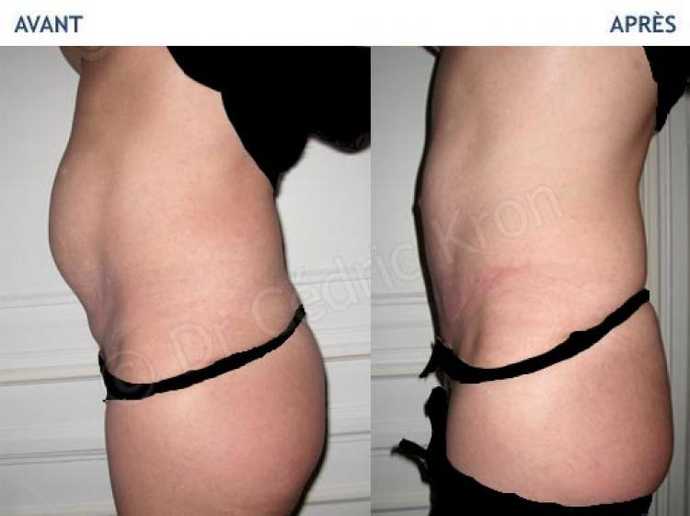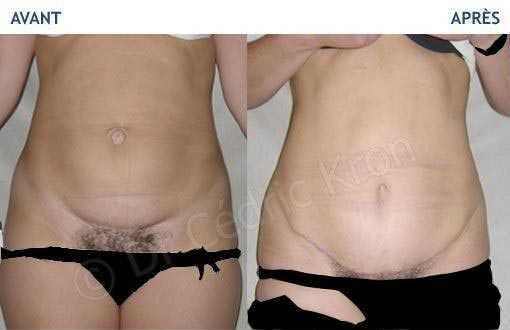A Tummy tuck (or abdominoplasty) is a cosmetic surgery procedure that corrects the appearance of the belly if it has excess of fat, of skin or muscle subsidence.
A Tummy tuck surgery tightens the skin distended at the level of belly, strengthens the abdominal belt and thins the waist. An abdominoplasty is a true "rejuvenation" of the belly that allows to recover a tonic and tight belly while maintaining its natural appearance.
What is a tummy tuck surgery ?
A tummy tuck surgery is a cosmetic and reconstructive surgery procedure of the belly. Sometimes called abdominoplasty or belly dermolipectomy, this surgery remodels the abdomen by removing excess fat, skin and by restructuring the muscles of the abdominal wall.
A tummy tuck can be performed for a strictly aesthetic purpose, but can also be performed to correct a functional disorder, allowing the patient to regain comfort and repair abdominal muscles.
For which type of patient?
This procedure is particularly appropriate for patients with belly skin in excess. This excess of skin can be due to the consequences of a pregnancy or following a significant weight loss.
Some thin patients also have a "forced" pregnancy belly with more or less muscular distention without fat overload. The abdominoplasty has its place in these people to retighten skin and muscle for which no rehabilitation or gymnastics would achieve results.
After a pregnancy or after a bypass
For woman, the abdomen is particularly weakened after a pregnancy, which induces a distension of the musculature and which has an action on the elasticity of the skin at the level of the belly. A tummy tuck is also an intervention indicated after a significant weight loss, either as a result of a diet or following a procedure of bariatric surgery ("by-pass", gastric ring).
A belly slimming treatment?
It is important to know that an abdominoplasty is not a slimming treatment even if it usually involves the removal of some fat excess by liposuction. This procedure can only remove stretch marks on the skin that will be removed, usually between the navel and pubis. It can allow the simultaneous treatment of certain parietal deficits. This may involve gaps between the vertical muscles of the abdomen and possible hernias.
For patient who underwent a major weight loss, a bodylift may be a more appropriate intervention. This is an operation that treats the basin area in a circular fashion. It also puts the hips in tension, to regale the buttocks and to correct the arch of the back. The results of a bodylift are spectacular, but it is a heavier intervention than a tummy tuck (in terms of recovery and post-operative follow-up).
Description of an abdominoplasty surgery
The objective of a tummy tuck is to restore tension to the relaxed muscles, as well as the cutaneous cover of the abdomen and to remove the excess fat located at the level of the belly thanks to liposuction.
The surgical technique
As in all cosmetic surgery, there is no universal abdominoplasty technique. Depending on the patient's initial anatomy, the surgeon will suggest the patient the most appropriate technique to achieve the desired result.
- A horizontal incision that rises slightly laterally is performed just above the pubis, as low as possible. Depending on the technique used and the initial morphology of the patient's abdomen, the shape and length of the incision may vary. The incision may involve the entire abdominal wall or only a part.
- The skin is then separated from the abdominal wall to the level of the ribs. If the muscles of the abdomen have been relaxed or removed during pregnancy, it is called diastasis. They are then stretched and stitched together along the midline. This allows the belly to be flatter and at the waist to be more cradled.
- The skin is pulled down and excess skin is removed. In some cases, it may be necessary to remove the belly button from the surrounding tissue and replace it after removing excess skin. There will be a scar around the umbilicus.
An abdominoplasty is always accompanied by a lipoaspiration of fat in excess, which allows for a thinner waist and limit the risk of detachment while maintaining intact the lymphatic vessels, facilitating the postoperative recovery.
Anesthesia
The procedure is most often performed under locoregional anesthesia, spinal anesthesia or epidural (as during childbirth) with associated sedation. It can also be performed under general anesthesia, but it is always associated with local anesthesia. These types of anesthesia provide very good control of postoperative pain.
Duration of an abdominoplasty
The duration of the intervention is generally between 1 hour 30 and 2 hours. Depending on the importance of the correction, however, the intervention may last substantially longer or shorter depending on the patient.

Recovery after a tummy tuck
The pain is moderate and can be relieved by simple analgesics in the absence of diastasis. They are a little more important in case of muscle repair, the analgesic treatment is then adapted.
Convalescence after this belly cosmetic surgery
At the end of the clinic, it is necessary to respect a total rest period of 10 days. The prolonged sitting position must be prohibited in the first days following the procedure. Getting up and walking the day after surgery is necessary to reduce the risk of phlebitis. Anticoagulant treatments are usually prescribed for ten days as a preventive measure.
The door of a compressive sheath is mandatory for 2 to 4 weeks following the procedure.
It is possible to return to work after 1-2 weeks. Sports activities can be performed after at least 4-6 weeks of recovery.
When can I see the result of a tummy tuck?
The result of the procedure can be assessed immediately despite postoperative edema. The edema gradually decreases in the days and weeks following the operation.
A physiotherapy of drainage and physiotherapy started in the days following the intervention is very useful to favor a faster and more comfortable recovery.
With Dr. Kron, you will leave the clinic with special dressings that will allow you to shower every day, the day after the intervention. These dressings will be systematically reviewed in consultation with Dr. Kron without you having to do them yourself or see a nurse (unless there are exceptions).
Optimize the result with XBody training
To optimize the results, sessions of XBody can be indicated. It is an electrostimulation device that allows postoperative muscular rehabilitation. The practice of XBody allows to physically redraw the silhouette and strengthen the belly effectively.
Scar induced by an abdominoplasty
Since a tummy tuck involves an incision and removal of skin tissues in excess, a scar is a mandatory sequel to this procedure.
During the preoperative consultation, the surgeon takes into account the lifestyle and dress habits of the patient in order to decide on the most appropriate technique and the position of the scar.
The scar is most often hidden below the undergarment line.
The evolution of the scar takes 6 to 12 months. First red, it will gradually become pink until the natural color of the skin. The scar becomes definitive after 12 to 18 months, depending on the patient.
Possible Risks
The risks of infection are very rare.
The risk of cutaneous necrosis is extremely rare. Necrosis can nevertheless occur in some patients, especially in the case of smoking.
Smoking increases the risk of surgical complications of any surgery. Stopping smoking 6-8 weeks before the procedure eliminates this additional risk. If you smoke, talk to your doctor, surgeon, and anesthesiologist, or call Tobacco-Info-Service at 3989 to help reduce risk and put the odds on your side.
Before & After: Tummy tuck surgery
